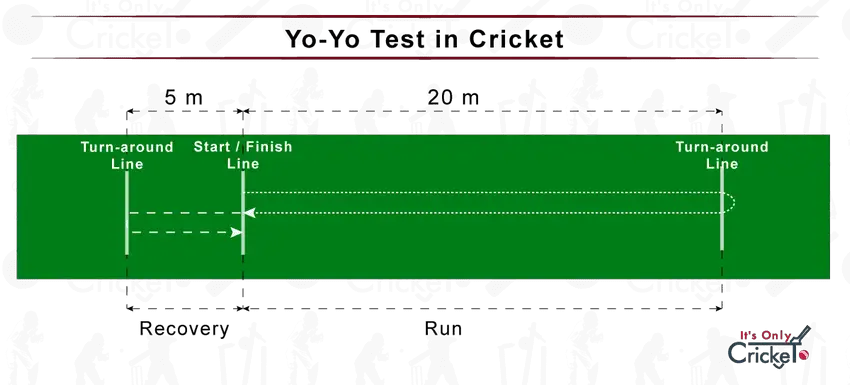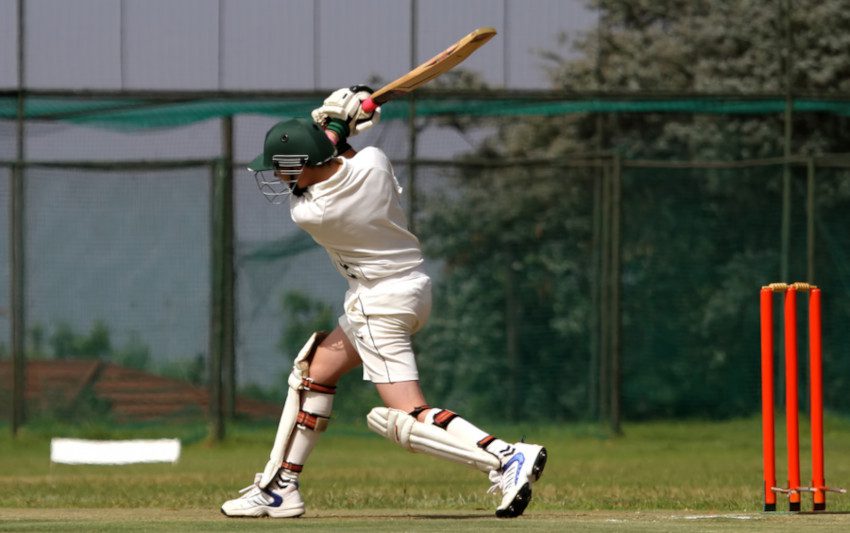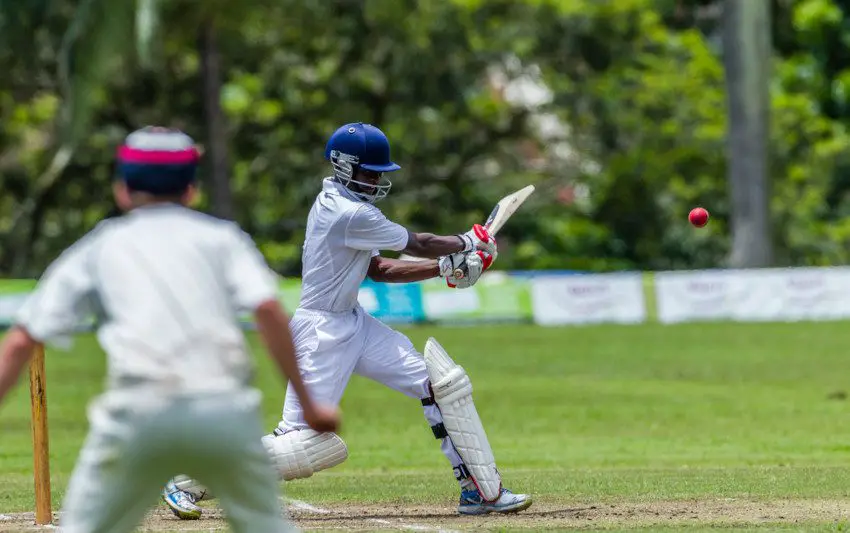Table of Contents
In modern day cricket, there is a great emphasis on high levels of fitness. One of the most strenuous challenges for players is known as the Yo-Yo test, but what is it and what does it tell us?
What is a Yo-Yo Test in Cricket?
A Yo-Yo test is a multi-faceted fitness test designed to measure a player’s capability of playing international cricket. Some international boards have made it compulsory for a player to pass the tests before they can be selected for a national squad.
All of the tests involved in the package are designed to test a player’s aerobic cardiovascular strength and their ability to withstand the pressure of the modern game. This isn’t a test for fundamental skill, the yo-yo challenge is all about fitness levels.
Shuttle in a Yo-Yo Test
The shuttle part of the Yo-Yo test measures a player as they run between two cones. Those cones are placed around 20 metres apart. The player sprints between the cones, and their speeds are measured.
This test is repeated until the runner has completed two kilometres, and there are time limits involved. For the fast bowlers in the team, the distance should be covered in a maximum timeframe of eight minutes and 15 seconds. For every other type of player, the time limit is eight minutes and 30 seconds.
This is designed to replicate a number of match scenarios. Batters have to sprint between the wickets and then stop when they have completed their running. Bowlers run into the crease, deliver the ball, and then stop abruptly.
Fielders have to sprint from a standing start to stop the ball. All of this ‘start, stop’ approach to the game helps to make cricket unique, and it’s one of the factors that is replicated by the shuttle test.

Types of Yo-Yo Tests
There are two levels of Intermittent Recovery (IR) Yo-Yo tests and a further two levels of Intermittent Endurance (IE) tests.
YoYo IR1
The initial level is known as IR1, and this focuses on the ‘capacity to carry out intermittent exercise leading to a maximal activation of the aerobic system’.
YoYo IR2
The second stage is a more vigorous test. This sets out to determine the individual’s ability to recover from repeated exercise with a high contribution from the anaerobic system.
YoYo IE1
IE stands for intermittent endurance, and these tests tend to be used in less strenuous sports. At the entry level of IE1, the test sets out to measure endurance levels across a longer form of competition.
YoYo IE2
This is simply a tougher set of testing than level one. Once again, this is an endurance test that is more likely to be seen in sports that are less strenuous than cricket.
Test Procedure – Step by Step
The coaches prescribe a certain approach to the yo yo test, and it uses six steps.
- Step One: Get Ready to Run – The runner prepares to begin in a sprinter’s stance.
- Step Two: Start the Shuttle – The player begins to run when they hear a beep from the coach. This is why a yo yo test is also called a beep test in places. The runner will need to reach the next cone before the second beep.
- Step Three: Turn Round – Once the second cone is reached, the runner turns around and faces back towards the first cone.
- Step Four: Beat the Third Beep – The runner returns to the starting point and has to get there before the third beep.
- Step Five: Recovery – A ten second recovery period now follows.
- Step Six: Repeat the process – The initial process is now repeated. The yo-yo test will continue in this fashion, increasing in intensity levels.
YoYo Test Scoring Method – Levels in a Yo-Yo Test
Occasionally, scores will be shown as a distance. For example, if you see a yo yo score of 1800, this means that the runner has covered a distance of 18 metres.
However, it’s more common to see smaller numbers such as 18, 19.1 etc.
The top level of yo yo testing is number 23, which runners are expected to complete at 19.5 kph. In reality, nobody gets close to this level.
More commonly, you may see a player complete seven shuttles at level 15 and fail on the eighth. Their yo yo score would then be recorded at 15.7.
Minimum Yo-Yo Test Scores
Minimum scores will differ depending on the sport involved. Within cricket, they will also vary between international boards. For example, the Indian cricket team has to hit a minimum yo-yo test score of 16.1.
Anyone who fails to reach that minimum score in testing will not be considered for selection.
Pakistan has a higher minimum score of 17.4 while the West Indies have set theirs at 19. At the very top end of the scale, it’s believed that New Zealand has the highest requirement of all with a minimum yo yo test score of 20.1. However, there is a confusing picture as the Kiwis have not made testing mandatory as yet.
Good Score in a Yo-Yo Test
This is open to some conjecture. Clearly, any player who is worried about their fitness will consider it a good score if they reach the minimum requirements.
In general, it’s felt that any return within 18 and 20 is considered to be an excellent score in a yo yo test and, as the following players show, it’s a good indication of their exceptional fitness.
Cricketers With Top Scores
Shan Masood – 22.1
Yo-yo test results show that Pakistan’s cricketers are supremely fit athletes. Left-handed batter Shan Masood joint leads this list with an exceptional figure of 22.1. A captain at international level, Mahsood is fast between the wickets, and his test scores back that up.
Muhammad Rizwan – 22.1
Joining his Pakistan team mate at the top of the leaderboard is Muhammad Rizwan. We know him as a wicket keeper, but he sometimes fields in the deep where his high yo-yo test score of 22.1 helps him cover the ground at great speed.
Jonny Bairstow – 21.8

An England international in all three formats. Jonny Bairstow played for many years as a wicket keeper. However, he now spends most of his time in the outfield and he also has to sprint between the wickets as a top order batter.
Bairstow’s levels of fitness are exemplary and are underlined by a Yo-Yo test which is measured at 21.8.
Maheesh Theekshana – 19.2
Sri Lanka’s off spinner Maheesh Theekshana may seem another unlikely candidate for a high test result. He is a slow bowler so he doesn’t expend too much energy, but he is very young and clearly very fit.
Theekshana’s Yo-yo test scores are also seriously impressive at 19.2.
Kagiso Rabada – 19.2

As somebody who bowls high levels of pace, South Africa’s Kagiso Rabada will obviously need to display fast recovery times. Despite putting his body on the line for many years, Rabada remains an all-format player at domestic and international level. He’ll more likely be used in short bursts of overs by whoever is captain of the team at the time.
He’ll need to maintain a good yo-yo test score, and he is another player to produce a high result of 19.2.
Manish Pandey – 19.2
Another cricketer with a yo-yo test result of 19.2 is the Indian batter Manish Pandey. For many years, he was on the fringes of the national team but he is an effective player when he finds form.
That form may be inconsistent, but his fitness isn’t in question as Pandey returns a high set of results.

Virat Kohli – 19

Virat Kohli completes this particular list with yo-yo test scores that come in at exactly 19. He has been India’s inspirational captain for many years, but we tend to forget that he is a world class batter and an excellent fielder. He has exceptional levels of fitness, and many cricket fans may not be aware that he is also one of the fastest runners on the circuit.
Kohli will need to maintain good results moving forward and those are exceptional figures.
Debate Over the Yo-Yo Test
Should the yo-yo test play such a big role in team selection? While fitness levels are clearly important, there are some players of the recent past who have struggled to get into sides because of their weight. Those individuals may well have lower scores, but their ability with the bat, ball or both, cannot be questioned.
There is a theory that the yo-yo test may be more important in limited overs games than in first class or test cricket. In ODIs and T20s, all players need to be extra quick between the wickets and across the ground when they are fielding. Test cricket is a slower form of the game, where the demand for speed may not be so high.
Opinion will be divided over this question. For what it’s worth, I believe that the yo-yo test is a useful tool, but a player shouldn’t be automatically ruled out if they fall under the levels. Each player should be considered as an individual case, and the yo-yo test shouldn’t be the sole judge of selection.
Yo-Yo Test FAQ
When was the First Yo-Yo Test?
The Yo-Yo test was devised in the 1990s and appeared in a white paper in 2008. Soccer teams adopted the process shortly afterwards.
In cricket, it’s thought that the first team to take part in the yo yo test were India, who started using it in 2017, ahead of their tour to Sri Lanka.
Who invented the Yo-Yo Test?
The man credited with inventing the Yo-Yo test is Dr Jens Bangsbo. A Danish scientist, Bangsbo was also a football coach and he wanted to implement a routine that wasn’t all about long distance running.
Realising that speed and recovery were a part of professional sport, Bangsbo devised the Yo-Yo test.

Conclusion
The question of fitness levels in cricket has come into sharper focus in recent years. I have just published an article on heavier cricketers, and I doubt that many of these would have been comfortable taking the Yo-Yo test.
Just like a healthy diet, it’s certainly a necessary part of the game, and it’s important to find out just how likely it is that your players can withstand the stresses and strains of international competition. The controversy, if there is any, relates to the fact that some boards will exclude players if they do not pass the test.
In summary, there is a confusing picture to an extent with different boards using different scoring requirements, but it’s certainly a useful test in the context of a sport that requires very high levels of fitness.


